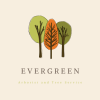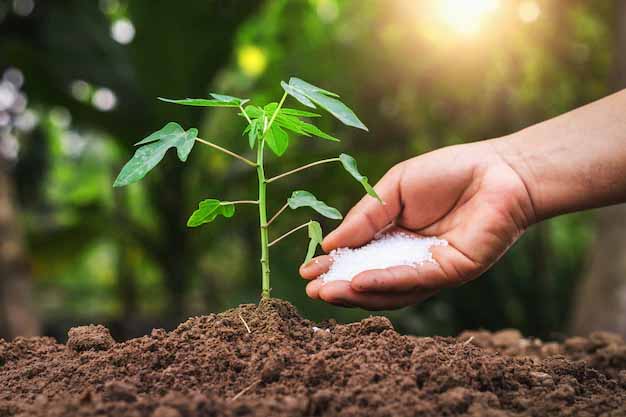Fertilizing is an important part of Tree care, We found this interesting article about Fertilizing in the book called “Northen California Gardening” by “Katherine Grace Endocott”. Here is a small excerpt form the book.
Fertilizing is the practice of supplying plants with nutrients;the three major or primary nutrients are nitrogen(N),phosphorus(P),and potassium(K).This gang of three are prominently displayed on fertilizer packages as a ratio,nitrogen:phosphorus:potassium(always in that order)such as 10N-10P-10K(the three nutrients are supplied in equal percentages)or 20-0-0(only nitrogen is supplied),or many other combinations.
In Northern California,gardeners will occasionally encounter iron deficiency in citrus and acid-loving plants such as azaleas or camellias.This will appear as yellowing between the veins of the leaves,and it is easily corrected by an iron supplement that has been chelated to make it easily absorbed by the plant.Sometimes plants grown in subsoil(the topsoil has usually been scraped away by builders)will show a zinc deficiency by producing very small mottled leaves.It is easily corrected with chelated zinc.Fertilizers formulated for rapid growth will be high in nitrogens,and those for-mulated to stimulate flowering,fruiting,and strong roots will be high in phosphorous.There are also fertilizers formulated for special plants such as African violets(8-14-6)or roses(18-24-16).There are also all-purpose fertilizers,which can be applied to every garden plant.
Fertilizing can be a complicated process or a simple one.The gardener can apply one type of fertilizer to most plants once a year(generally early in the spring)or develop a complex schedule of applying a variety of fertilizers to different plants throughout the year.The gardener can also decide not to fertilize at all;the garden will continue to grow.
Some organic gardeners argue that enriching the soil with compost supplies all the nutrients that plants need,and that the use of commercial fertilizers should be avoided.Organic gardeners also argue that synthetic chemical(nonorganic)fertilizers acidify the soil and consequently repel earth-worms.It is certainly true that when lots of fertilizer is supplied,some plants burst into an abundance of tender new growth that attracts insects.It is also true that rampant growth is not always desirable because it may need to be pruned.
In addition to the synthetic chemical fertilizers widely available in nurseries and hardware stores, there are organic fertilizers.The following are some of the more popular,along with the typical NPK ratio for each:alfalfa pellets(5-1-2),animal manure(0.6-0.1-0.5),blood meal(11-0-0),coffee grounds(2-0.3-0.2),compost(0.5-0.3-0.8),fish emulsion(4-1-1),fish meal(5-3-3),mushroom com- post (0.7-0.3-0.3,but varies greatly),oak leaves(0.8-0.4-0.1),and sawdust(0.2-0-2.3).Organic gardeners also use as fertilizers inorganic minerals such as Epsom salts(ten percent magnesium,thirteen percent sulfur),and rock phosphate(0-3-0).
Organic fertilizers need to be applied in huge amounts.For example,to fertilize an area ten feet by ten feet would require two pounds of a synthetic chemical fertilizer(10-10-10)or five pounds of alfalfa pellets(5-1-2)or thirty-five pounds of mushroom compost (0.5-0.3-0.8).Organic fertilizers also improve soil texture,and some of them are used as soil amendments.Synthetic chemical fertilizers have the advantage in early spring when cold soil temperatures thwart the release of organic nutrients.
Fertilizers,both organic and synthetic,come in many different forms.The most popular form is dry;a dry,granular fertilizer is easily sprinkled evenly over the root area in the amount recommended on the fertilizer package and watered in well.Be careful to keep the dry fertilizer off leaves and stems to prevent burning.
Water-soluble fertilizers are dissolved in water and poured or sprayed on roots.The problem with water-soluble fertilizers is that the gardener needs to keep applying them because once they pass beyond the roots they are literally washed away.
Liquid foliar fertilizers are sprayed onto the leaves of plants.They are most effective early in the spring before a tough waxy coat forms on the surface of the leaf.Liquid fertilizers are mixed with water and can be applied to both roots and leaves.Fish emulsion and liquid kelp are liquid fertilizers that are often used as foliar sprays to give plants an extra boost.
Slow-release fertilizers are very popular with container gardeners because they release nutrients over a long period of time;often you will see the round grey capsules sprinkled on top of nursery-grown container plants. Slow-release fertilizers are also safer than water-soluble fertilizers that can burn roots if used in concentrations that are too high.
There are several general guidelines for using fertilizers.Fertilizers are usually applied before a plant blooms;for fruit trees this can mean very early in the year.Fertilize citrus with a high-nitrogen citrus fertilizer that includes iron because iron chlorosis(yellowing)is a common problem in Northern California.Other trees and shrubs often benefit from a high-nitrogen fertilizer with a formula such as 20-10-10.If you use granular fertilizer,make sure to water it in well.Not everything should be fertilized.Cacti,succulents,and some native plants should not be fertilized.Gardens with rampant,hard-to-control growth would be easier to handle with less or no fertilizer.When in doubt,it is far better to apply too little fertilizer than too much.

